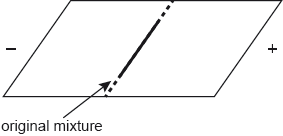| Date | May 2019 | Marks available | 2 | Reference code | 19M.3.hl.TZ1.9 |
| Level | HL | Paper | 3 | Time zone | TZ1 |
| Command term | Deduce | Question number | 9 | Adapted from | N/A |
Question
Aspartame is a derivative of a dipeptide formed between two amino acids, phenylalanine (Phe) and aspartic acid (Asp).
Draw a circle around the functional group formed between the amino acids and state its name.
Name:
A mixture of phenylalanine and aspartic acid is separated by gel electrophoresis with a buffer of pH = 5.5.
Deduce their relative positions after electrophoresis, annotating them on the diagram. Use section 33 of the data booklet.
Aspartic acid is obtained synthetically as a racemic mixture. Draw the three‑dimensional shape of each isomer showing their spatial relationship to each other. Use section 33 of the data booklet.
Markscheme
Name:
amide/amido/carboxamide [✔]
Note: Accept “peptide bond/linkage”.
Phe: must be on the origin [✔]
Asp: any position on the left/anode/+ side [✔]
[✔]
Examiners report
Candidates were challenged to draw a circle around the functional group formed between the two amino acids in a dipeptide. Commonly the central C=O or the N-H groups were circled instead of the amide. Some candidates then named the functional group as a ketone or amine, however most candidates stated “peptide” here and scored a mark.
Most candidates correctly deduced the positions of the two amino acids after electrophoresis.
Was very poorly answered. Many candidates had difficulty drawing a 3D structure and showing the spatial relationship of two enantiomers. An incorrect amino acid residue was often used, or incorrect bond connections drawn.


